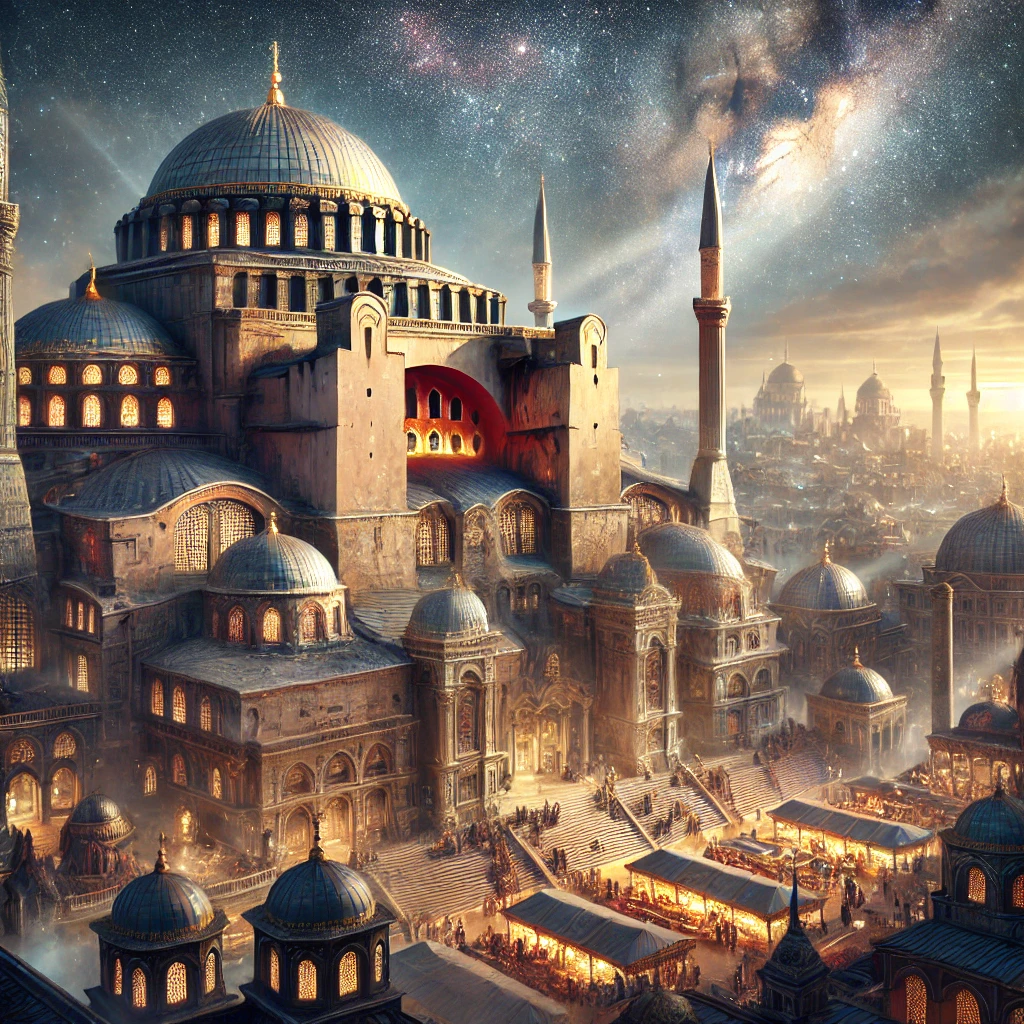Byzantium: The Forgotten Empire of Angels and Saints

Throughout history, certain cities have served as more than just political or cultural hubs; they’ve stood as beacons of hidden knowledge and spiritual power. Kiev and Constantinople are two such cities, whose legacies stretch far beyond their ancient walls. Rooted in divine symbolism and mystical traditions, their influence may not just be historical—it could be affecting our present. As UFO sightings intensify over New Jersey, some believe these modern phenomena are echoes of ancient forces tied to these sacred civilizations. Could the spiritual energy and hidden knowledge of Byzantium and Kiev be resurfacing, influencing not just the skies but global events in 2025?
Byzantium, often regarded as a jewel of ancient civilization, stands as a testament to both divine mystery and human ingenuity. Some believe that the city was crafted by angels and the 144,000 millennial saints during a thousand-year reign, a period that mainstream history may have conveniently erased. This notion ties into the broader belief that the Byzantine Empire wasn’t just a political power but a manifestation of a celestial kingdom on Earth. The grandeur and sophistication of Byzantium, particularly Constantinople, are often cited as evidence of this divine intervention, with architecture and cultural achievements seemingly beyond the capabilities of their time.
Many believe this divine presence resurfaced throughout history, shaping Capitol Buildings and other monumental structures worldwide. These buildings, with their intricate designs and advanced construction techniques, hint at celestial involvement, echoing the architectural marvels of Byzantium. This theory aligns with ideas from the Great Reset and mud flood events, suggesting that our understanding of history may obscure repeated divine interventions that left behind these enduring symbols of otherworldly influence.
Reflecting on my own encounters with these Beings, I perceive a profound connection to ancient Greek culture. The intricate symbols and codes I witnessed bear a striking resemblance to Greek alchemical texts, which blend geometric shapes and Greek letters. This suggests that the messages conveyed to me might be rooted in a language and symbolism reminiscent of Greek traditions. The fusion of spiritual and philosophical elements in these experiences further aligns with the essence of Greek alchemy, indicating that the phenomena I observed may be deeply linked with this ancient wisdom.
Reflecting on my encounters inside a UFO, the interior design mirrored the architectural splendor of Byzantium and the grandeur of Capitol Buildings. The sweeping arches, intricate detailing, and ethereal lighting felt sacred, resembling the Hagia Sophia or the dome of the U.S. Capitol. Inside a UFO, the symmetry and elegance seemed intentional, creating an environment that evoked both authority and serenity. Towering columns lined the corridors, their polished surfaces reflecting the ambient light, reinforcing the sense that I wasn’t just in a vessel, but a cathedral in motion, bridging the divine and the human.
The relationship between the Greek gods and Byzantium is complex, rooted in the transition from ancient pagan traditions to Christian dominance. Byzantium, later known as Constantinople, was originally a Greek colony, and like much of the Greek world, it was steeped in the mythology and worship of the Olympian gods—Zeus, Athena, Apollo, and others. However, when Emperor Constantine the Great established Constantinople as the new capital of the Roman Empire in 330 AD, the city became the heart of the Byzantine Empire and a stronghold of Christianity.
Byzantium, often dubbed the “eye of all the world,” was the heart of a long-forgotten empire that spanned over a thousand years, merging the grandeur of pagan Rome with the spiritual aspirations of Christianity. The crowning glory of this empire was Hagia Sophia, the Church of Divine Wisdom, symbolizing not only architectural brilliance but also the religious and political power of Byzantium. Founded by Constantine the Great in 330 AD, who mysteriously chose a small Greek town as his new capital, Constantinople (modern-day Istanbul) became the beating heart of the Byzantine Empire, a fusion of Eastern and Western influences. Constantine’s procession, filled with relics like Noah’s axe and baskets of crumbs from Christ’s miracles, marked the city’s dedication to Christian governance on Earth.
Byzantium’s influence stretched far beyond its borders, from Spain to Syria, and from northern Russia down to the upper Nile. The empire’s architecture, art, and governance were mirrored in cities across Europe and the Middle East, leaving an indelible mark on history. The emperors, both revered and feared, were capable of brutal acts—mutilating courtiers, blinding armies, and executing priests—yet they also fostered some of the world’s most exquisite art and architecture. The city itself was a marvel, built with prefabricated marble from the island of Marmara, and sustained by an intricate system of aqueducts and food supply chains that supported its vast population.
Constantinople was a city of contrasts, where the grandeur of imperial palaces and churches like Hagia Sophia coexisted with bustling markets and humble vegetable plots. The empire’s economy thrived on Mediterranean staples like wine, grain, and olive oil, the latter produced in sophisticated presses that highlight Byzantium’s advanced engineering. The cultural and religious life of Byzantium was equally rich, blending ancient Roman traditions with Christian innovations. Saints like Simeon Stylites, who lived atop a pillar, became symbols of the empire’s unique spiritual landscape, balancing Roman order with Christian mysticism.
The empire’s decline didn’t signal the fall of Rome but rather a shift in power back to its eastern roots. Even after losing its European provinces, Byzantium under emperors like Justinian reclaimed territories and left a legacy of art and architecture that would influence the world for centuries. Justinian and his wife Theodora’s reign epitomized this era of renewal, with monumental constructions like Hagia Sophia standing as testaments to their vision. The Byzantine Empire, born from the remnants of Rome and infused with Christian faith, remains a testament to humanity’s ability to blend the sacred and the secular, the ancient and the new, in a civilization that continues to shape our world today.
The Byzantine Empire, often shrouded in both grandeur and mystery, is believed by some to have been constructed with the divine assistance of angels and the 144,000 millennial saints during its thousand-year reign, a notion that modern history books have seemingly erased.
From its foundation in 330 AD by Constantine the Great, Constantinople stood as the beacon of a new Christian state, an empire radiating both religious fervor and imperial might. The oldest Christian books, rich with illustrations, served as vehicles for spreading biblical narratives across the Mediterranean, their images becoming foundational to Western art. Pagan iconography, such as depictions of Jupiter with halos and globes, seeped into Christian visual culture, influencing portrayals of Christ and saints, showing how deeply intertwined pagan and Christian symbolism had become.
The empire’s cultural heart pulsed in Constantinople, where processions through ancient streets revealed the empire’s dual nature: one of divine aspiration and worldly power. Ivory carvings from around 420 AD, depicting Emperor Theodosius II and his court, captured these sacred ceremonies. Empress Pulcheria’s prominence, holding the cross and receiving relics, marked a revolutionary shift, elevating women within the spiritual hierarchy and influencing Christianity’s view of female sanctity. Yet, Byzantium wasn’t just a stage for religious evolution; it also struggled with internal tensions, as the push for a morally upright, equitable city clashed with the opulence and inequality of its society.
The art and iconography of Byzantium, crafted in monasteries like St. John Studios, became battlegrounds for faith and power. The tension between pagan past and Christian future manifested in the images adorning churches, where pagan motifs of generals and banquets morphed into Christian narratives like the Last Supper. But the empire’s stability was fragile. The spread of Islam, the collapse of Persian resistance, and the devastating bubonic plague shattered Byzantium’s vast territories. Iconoclasm, the fierce destruction of religious images, further tore at the empire’s fabric, as emperors sought to consolidate divine power while monks and artists fought to preserve sacred art.
Despite the tumult, Byzantium’s legacy persisted through its art, architecture, and influence on neighboring cultures, from Russia to Central Europe. The grandeur of Constantinople, especially the Hagia Sophia, became a symbol of divine authority and cultural supremacy, even as the empire crumbled under external pressures and internal decay. By the time the Virgin was said to have taken her image back to heaven on the eve of Constantinople’s fall in 1453, Byzantium had already woven its eternal presence into the fabric of history, leaving behind more than just ruins—it left a story of divine ambition, human struggle, and the enduring power of symbols.
Ambassadors from Byzantium, laden with relics and the word of God, ventured north despite the empire’s aversion to winter travel. Diplomats would carry gold bars stamped with the emperor’s seal, hidden beneath furs on sledges, to bribe local chieftains into warring amongst themselves rather than threatening Constantinople. This strategy underscores the empire’s blend of diplomacy and subtle control over neighboring tribes, using wealth and religious prestige as tools of influence. Traveling through icy, treacherous territories, these envoys faced not just natural hardships but also the threat of ancient tribes who took pride in ambushing travelers and using their skulls as grotesque trophies.
As these ambassadors crossed frozen rivers and approached the formidable fortress of Kiev, they encountered the profound influence Byzantium had over the region. Before Byzantium’s cultural reach extended northward, the princes of Kiev lived in humble wooden structures. But after adopting Byzantine architectural and religious elements, their cities flourished with towers and domes, symbols of a civilization deeply intertwined with the Byzantine legacy. The construction of churches in Kiev, particularly under Prince Vladimir, showcased this transformation. Byzantine bishops and craftsmen brought their knowledge to the region, blending Greek and Roman technology into a land they never militarily conquered but spiritually and culturally dominated.
The Cathedral of St. Sophia in Kiev stands as a monument to Byzantine influence, its mosaics and architectural design echoing the grandeur of Constantinople. These structures weren’t just places of worship; they were visual representations of the Heavenly Court on Earth, designed to impress and pacify the northern tribes while subtly imparting Byzantine manners, gestures, and governance styles. Despite this influence, the Byzantines never fully trusted the Roose (Russians), perhaps wary of their growing power and the eventual shift of the “Third Rome” title to Moscow after Constantinople’s fall.
Venice, too, was deeply envious of Byzantium’s wealth and culture. The Venetian plundering of Constantinople during the Fourth Crusade in 1204 brought countless treasures to Western Europe, embedding Byzantine influence into the very heart of cities like Venice. The Pala d’Oro, an ornate altarpiece in St. Mark’s Basilica, is a cobbled mosaic of Byzantine enamel and gold, showcasing both the empire’s artistic prowess and the Venetians’ desire to appropriate its splendor. However, subtle alterations in these artworks, like adding halos to local rulers or manipulating religious symbolism, reflect Venice’s attempt to elevate its status by aligning itself with Byzantine grandeur.
The fall of Constantinople in 1453 marked not just the end of an empire but the beginning of a cultural and intellectual migration to the West. Byzantine scholars, like Plethon and Bessarion, carried ancient Greek philosophy and knowledge to Renaissance Italy, igniting a revival of classical learning. This intellectual migration bridged the ancient and modern worlds, infusing Western Europe with the wisdom of Byzantium. The artifacts and relics plundered from Constantinople, once symbols of divine authority, were now scattered across Europe, fueling the rise of new powers and ideologies.
Despite its fall, Byzantium’s legacy endures. The architectural remnants, religious artifacts, and philosophical ideas continue to shape modern civilization. The empire’s vision of a universal order, blending divine authority with earthly governance, remains a fundamental part of Western thought. Constantinople, now Istanbul, carries the echoes of its Byzantine past, a city where East meets West. The story of Byzantium is not just a tale of an empire lost to time but a reflection of humanity’s quest for power, knowledge, and a connection to the divine. As strange phenomena unfold in the skies over New Jersey and other places, it’s hard to dismiss the possibility of a deeper connection. The architectural grandeur, spiritual symbolism, and celestial ties of these ancient civilizations may be resurfacing in unexpected ways, linking the past to our present reality.


